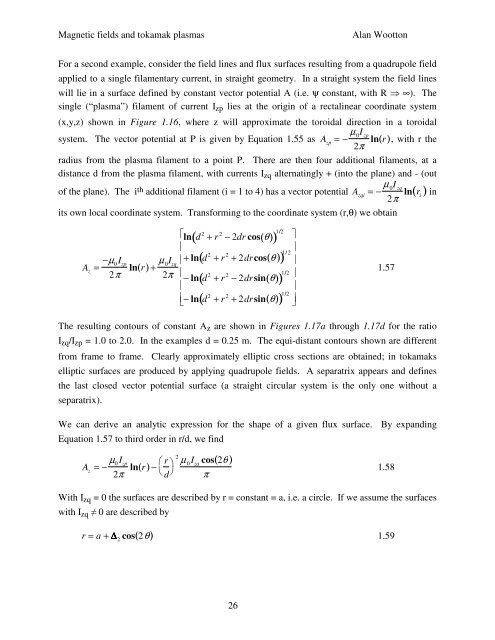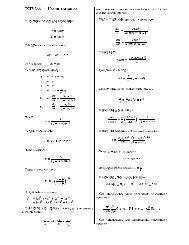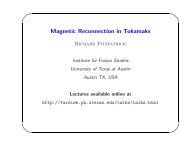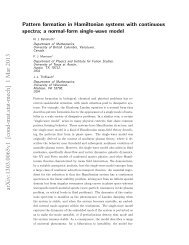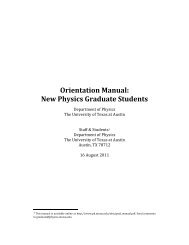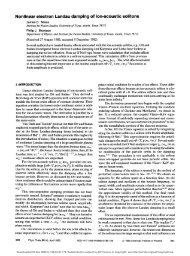Magnetic Fields and Magnetic Diagnostics for Tokamak Plasmas
Magnetic Fields and Magnetic Diagnostics for Tokamak Plasmas
Magnetic Fields and Magnetic Diagnostics for Tokamak Plasmas
You also want an ePaper? Increase the reach of your titles
YUMPU automatically turns print PDFs into web optimized ePapers that Google loves.
<strong>Magnetic</strong> fields <strong>and</strong> tokamak plasmas<br />
Alan Wootton<br />
For a second example, consider the field lines <strong>and</strong> flux surfaces resulting from a quadrupole field<br />
applied to a single filamentary current, in straight geometry. In a straight system the field lines<br />
will lie in a surface defined by constant vector potential A (i.e. ψ constant, with R ⇒ ∞). The<br />
single (“plasma”) filament of current I zp lies at the origin of a rectalinear coordinate system<br />
(x,y,z) shown in Figure 1.16, where z will approximate the toroidal direction in a toroidal<br />
system. The vector potential at P is given by Equation 1.55 as A zp<br />
= − µ 0I zp<br />
2π ln ( r ), with r the<br />
radius from the plasma filament to a point P. There are then four additional filaments, at a<br />
distance d from the plasma filament, with currents I zq alternatingly + (into the plane) <strong>and</strong> - (out<br />
of the plane). The i th additional filament (i = 1 to 4) has a vector potential A zqi<br />
= − µ 0I zq<br />
2π ln ( r i<br />
) in<br />
its own local coordinate system. Trans<strong>for</strong>ming to the coordinate system (r,θ) we obtain<br />
A z<br />
= −µ 0 I zp<br />
2π<br />
ln( r)<br />
+ µ I 0 zq<br />
2π<br />
( ) 1/2<br />
⎡ ln d 2 + r 2 − 2dr cos( θ)<br />
⎢<br />
⎢ + ln d 2 + r 2 + 2drcos( θ )<br />
⎢<br />
− ln d 2 + r 2 − 2drsin( θ)<br />
⎢<br />
⎣<br />
⎢ − ln d 2 + r 2 + 2drsin( θ)<br />
( ) 1/ 2<br />
( ) 1/2<br />
( ) 1/2<br />
⎤<br />
⎥<br />
⎥<br />
⎥<br />
⎥<br />
⎦<br />
⎥<br />
1.57<br />
The resulting contours of constant A z are shown in Figures 1.17a through 1.17d <strong>for</strong> the ratio<br />
I zq /I zp = 1.0 to 2.0. In the examples d = 0.25 m. The equi-distant contours shown are different<br />
from frame to frame. Clearly approximately elliptic cross sections are obtained; in tokamaks<br />
elliptic surfaces are produced by applying quadrupole fields. A separatrix appears <strong>and</strong> defines<br />
the last closed vector potential surface (a straight circular system is the only one without a<br />
separatrix).<br />
We can derive an analytic expression <strong>for</strong> the shape of a given flux surface. By exp<strong>and</strong>ing<br />
Equation 1.57 to third order in r/d, we find<br />
A z<br />
= − µ 0<br />
I zp<br />
2π ln( r)<br />
− ⎛ r ⎝ d<br />
⎞<br />
⎠<br />
2<br />
µ 0<br />
I zq<br />
cos( 2θ )<br />
π<br />
1.58<br />
With I zq = 0 the surfaces are described by r = constant = a, i.e. a circle. If we assume the surfaces<br />
with I zq ≠ 0 are described by<br />
r = a + ∆ 2<br />
cos( 2θ) 1.59<br />
26


